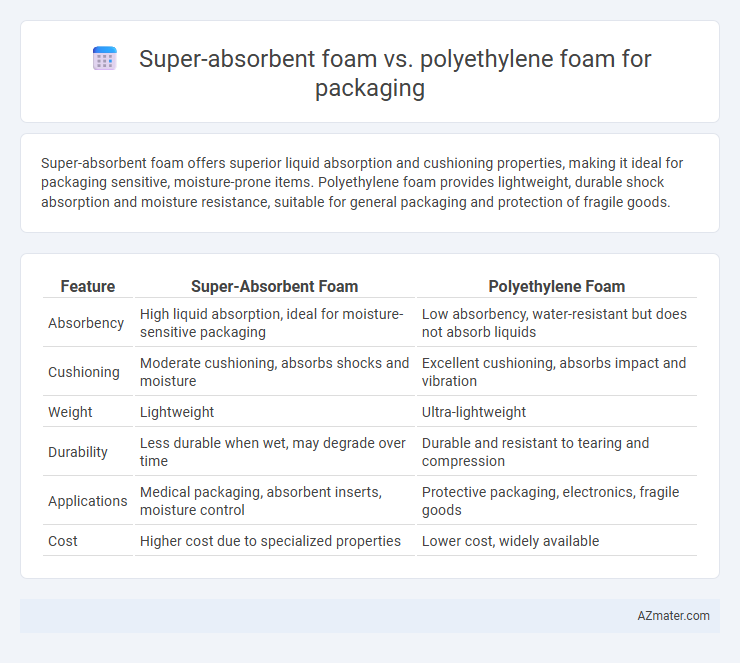Super-absorbent foam offers superior liquid absorption and cushioning properties, making it ideal for packaging sensitive, moisture-prone items. Polyethylene foam provides lightweight, durable shock absorption and moisture resistance, suitable for general packaging and protection of fragile goods.
Table of Comparison
| Feature | Super-Absorbent Foam | Polyethylene Foam |
|---|---|---|
| Absorbency | High liquid absorption, ideal for moisture-sensitive packaging | Low absorbency, water-resistant but does not absorb liquids |
| Cushioning | Moderate cushioning, absorbs shocks and moisture | Excellent cushioning, absorbs impact and vibration |
| Weight | Lightweight | Ultra-lightweight |
| Durability | Less durable when wet, may degrade over time | Durable and resistant to tearing and compression |
| Applications | Medical packaging, absorbent inserts, moisture control | Protective packaging, electronics, fragile goods |
| Cost | Higher cost due to specialized properties | Lower cost, widely available |
Introduction to Packaging Foams
Packaging foams play a critical role in protecting products during transit and storage by providing cushioning and shock absorption. Super-absorbent foam features high liquid retention capabilities, making it ideal for moisture-sensitive items, while polyethylene foam offers lightweight, durable cushioning with excellent resistance to impact and compression. Both materials enhance package integrity but are selected based on specific protection requirements such as moisture control or impact resistance.
What is Super-Absorbent Foam?
Super-absorbent foam is a type of packaging material designed to absorb and retain large amounts of liquid, offering superior moisture management compared to traditional foams. This material is engineered with a porous structure that can trap water and other fluids, making it ideal for protecting sensitive products from damage caused by spills or condensation. Unlike polyethylene foam, which primarily provides cushioning and shock absorption, super-absorbent foam combines impact protection with high liquid retention capabilities.
Overview of Polyethylene Foam
Polyethylene foam is a versatile packaging material known for its lightweight, shock-absorbing properties and excellent resistance to moisture and chemicals. Its closed-cell structure provides effective cushioning and protection for delicate items during shipping and storage. Compared to super-absorbent foam, polyethylene foam offers superior durability and reuse potential, making it a cost-efficient choice for a wide range of packaging applications.
Key Differences Between Super-Absorbent and Polyethylene Foam
Super-absorbent foam excels in absorbing and retaining large volumes of liquids, making it ideal for packaging products that require moisture control or spill containment. Polyethylene foam offers superior cushioning, impact resistance, and lightweight protection for fragile items, with excellent chemical and moisture resistance but minimal liquid absorption. Key differences include super-absorbent foam's hydrophilic properties versus polyethylene foam's inert, closed-cell structure designed primarily for shock absorption and insulation.
Absorption Capabilities Compared
Super-absorbent foam exhibits superior absorption capabilities compared to polyethylene foam, with its ability to retain large volumes of liquids due to its porous, cross-linked polymer structure. Polyethylene foam primarily provides cushioning and shock absorption but has limited liquid absorption capacity, making it less effective in environments requiring moisture management. The high absorbency of super-absorbent foam makes it ideal for packaging applications involving spills, moisture-sensitive products, or liquid containment.
Durability and Cushioning Performance
Super-absorbent foam offers superior cushioning performance due to its ability to absorb shock and distribute impact forces evenly, making it ideal for fragile and high-value items. Polyethylene foam, known for its durability, provides excellent resistance to wear, compression, and moisture, ensuring long-term protection during transportation and storage. While super-absorbent foam excels in impact absorption, polyethylene foam's robustness supports repeated use and maintains structural integrity under heavy loads.
Environmental Impact and Sustainability
Super-absorbent foam offers superior biodegradability compared to polyethylene foam, significantly reducing long-term environmental pollution in packaging applications. Polyethylene foam, derived from non-renewable petroleum sources, contributes to plastic waste accumulation and has limited recyclability, posing challenges for sustainable packaging solutions. Innovations in super-absorbent foam leverage eco-friendly materials that enhance compostability and reduce carbon footprint, aligning with global sustainability goals in packaging.
Cost Considerations in Packaging Applications
Super-absorbent foam typically incurs higher costs compared to polyethylene foam due to its specialized materials and enhanced moisture absorption capabilities, making it ideal for packaging sensitive electronics or medical devices. Polyethylene foam offers a more economical solution with adequate cushioning and impact resistance for general packaging needs, balancing performance and budget effectively. Cost considerations must weigh the specific protection requirements against material expenses to optimize packaging investment.
Ideal Use Cases for Each Foam Type
Super-absorbent foam is ideal for packaging applications requiring moisture control and liquid containment, such as medical device shipments or perishable goods protection, where its ability to absorb large volumes of liquid prevents damage. Polyethylene foam excels in cushioning and impact protection for electronics, fragile items, and industrial components, providing lightweight, durable, and shock-resistant packaging. Choosing between the two depends on whether moisture absorption or physical impact resistance is the primary packaging requirement.
Choosing the Best Foam for Your Packaging Needs
Super-absorbent foam offers superior liquid retention and cushioning, making it ideal for packaging sensitive electronics or medical supplies prone to moisture damage. Polyethylene foam provides excellent impact resistance, lightweight padding, and chemical stability, suitable for general protective packaging and heavy-duty applications. Evaluating product fragility, environmental exposure, and cost-effectiveness helps determine the best foam type to ensure optimal protection and durability during shipping.

Infographic: Super-absorbent foam vs Polyethylene foam for Packaging
 azmater.com
azmater.com